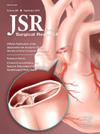糖尿病心肌伤口血运重建受损与透皮H2S减少有关
IF 1.7
3区 医学
Q2 SURGERY
引用次数: 0
摘要
随着糖尿病患病率的持续上升,与糖尿病性伤口不愈合相关的发病率也越来越普遍。硫化氢(H2S)作为一种重要的信号分子在伤口愈合和血管生成中得到越来越多的认可。肥胖和糖尿病与循环和透皮H2S水平降低有关,但伤口愈合过程中皮肤H2S排放的研究尚未得到证实。本研究旨在描述H2S在糖尿病缺血性伤口愈合和血供重建过程中的生理变化。材料与方法采用sprague Dawley和Zucker糖尿病脂肪(ZDF)大鼠全层缺血肌皮瓣创面。血管重建随访14天,采用连续激光散斑对比成像和愈合期间透皮H2S排放。组织学观察缺血组织损伤程度(肉环厚度)和新生血管形成情况(CD31免疫组化)。Western免疫印迹法检测血管内皮生长因子。结果zdf大鼠在基线和皮瓣植入期间皮肤灌注受损[64个灌注单位(PU)比184个PU, P <;0.01],这反映了愈合皮瓣伤口H2S排放的缺陷(十亿分之十[ppb]对28 ppb, P <;0.01)。与Sprague Dawley相比,ZDF动物的组织缺血性损伤和新生血管明显更严重(CD31+血管/mm2 12对20,P = 0.02),这与血管内皮生长因子表达比非糖尿病动物低两倍相关。结论糖尿病缺血性创面存在经皮H2S排放障碍,并与创面血运重建、血流灌注、组织结构维持、新生血管形成和血管生成信号的缺陷有关。H2S疗法可能是解决这一具有挑战性的临床问题的一种可行的新选择。本文章由计算机程序翻译,如有差异,请以英文原文为准。
Impaired Diabetic Myocutaneous Wound Revascularization Is Associated With Reduced Transdermal H2S
Introduction
As the prevalence of diabetes mellitus continues to rise, morbidity associated with nonhealing diabetic wounds is becoming more common. Hydrogen sulfide (H2S) has been increasingly recognized as an important signaling molecule in wound healing and angiogenesis. Obesity and diabetes are associated with decreased levels of circulating and transdermal H2S, but skin H2S emissions during wound healing have not previously been established. This study aims to describe H2S physiology during diabetic ischemic wound healing and revascularization.
Materials and Methods
Sprague Dawley and Zucker diabetic fatty (ZDF) rats underwent creation of full-thickness ischemic myocutaneous flap wounds. Revascularization was followed for 14 days by serial laser speckle contrast imaging and transdermal H2S emissions during healing. The degree of ischemic tissue injury (panniculus carnosus thickness) and neovascularization (CD31 immunohistochemistry) were assessed histologically. Vascular endothelial growth factor was measured by Western immunoblot.
Results
ZDF rats were observed to have impaired skin perfusion at baseline and during flap engraftment [64 perfusion units (PU) versus 184 PU, P < 0.01], which mirrored deficits in H2S emissions of the healing flap wound (10 parts per billion [ppb] versus 28 ppb, P < 0.01). Significantly worse tissue ischemic injury and neovascularization were noted in ZDF animals compared to Sprague Dawley (12 CD31+ vessels/mm2 versus 20, P = 0.02), which correlated with a two-fold deficit in vascular endothelial growth factor expression compared to nondiabetic animals.
Conclusions
Impairments in transdermal H2S emissions are present in diabetic ischemic wounds and are associated with deficits in wound revascularization, perfusion, maintenance of tissue architecture, neovascularization, and angiogenic signaling. H2S therapies may be a viable novel option for this challenging clinical problem.
求助全文
通过发布文献求助,成功后即可免费获取论文全文。
去求助
来源期刊
CiteScore
3.90
自引率
4.50%
发文量
627
审稿时长
138 days
期刊介绍:
The Journal of Surgical Research: Clinical and Laboratory Investigation publishes original articles concerned with clinical and laboratory investigations relevant to surgical practice and teaching. The journal emphasizes reports of clinical investigations or fundamental research bearing directly on surgical management that will be of general interest to a broad range of surgeons and surgical researchers. The articles presented need not have been the products of surgeons or of surgical laboratories.
The Journal of Surgical Research also features review articles and special articles relating to educational, research, or social issues of interest to the academic surgical community.

 求助内容:
求助内容: 应助结果提醒方式:
应助结果提醒方式:


